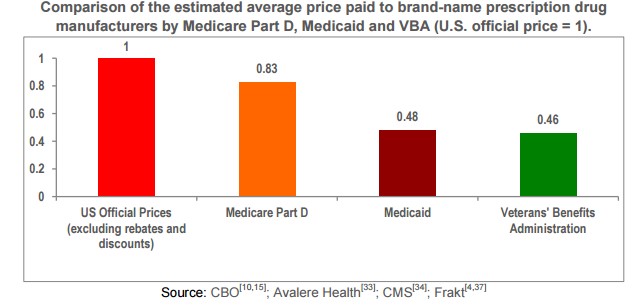Because of the ban on direct negotiating, Medicare Part D pays on average 73 percent more than Medicaid and 80 percent more than the Department of Veterans Affairs for brand name drugs. If the law were changed and if Medicare paid the same prices as Medicaid or Veterans Affairs, the federal government could save between $15.2 and $16 billion a year.
But this isn’t an easy win.
President Trump on Wednesday once again says he supports the idea of Medicare negotiating with pharmaceutical companies to lower drug prices for seniors. Allowing Health and Human Services to negotiate prices for 40 million people would require a change in the “Part D” law that was implemented in 2003.
Trump’s commitment brought praise from some Democrats who have urged him to make this a priority to help reduce government spending on prescription drugs. Trump met yesterday with House Democrats Elijah E. Cummings of Maryland and Peter Welch of Vermont to discuss their proposals.
Related: Is the Republican Health Care Bill Headed for a Do-Over?
“The President was clearly very much aware what was going on,” said Cummings, the ranking Democrat on the House Oversight and Government Reform Committee after the nearly one-hour meeting at the White House. “He understood the issue very well. And he felt it was important that we address this issue head on.”
But in the face of decades of opposition from the pharmaceutical industry and Trump’s daunting challenge in lining up support for the House GOP’s plan to replace the Affordable Care Act, action to strengthen Medicare’s negotiating hand may be a bridge too far this year.
“My guess would be that this is something they’re going to shelve this year,” said Michael Cannon, a health care policy expert with the libertarian Cato Institute. “They’re asking a lot of the rank and file just to go along with this health care bill, and that idea – for better or worse –is one that does not pay well among the rank and file Republicans in the House and Senate.”
The White House issued a statement after the meeting with Cummings and Welch saying the president wanted to work together in a bipartisan fashion to make prescription drugs more affordable.
Related: Trump Says He Is Working To Bring Down Drug Prices
Calls for drug price containment to ease the government’s health care costs ricocheted throughout the 2016 presidential campaign. Trump and Democratic candidates Hillary Clinton and Sen. Bernie Sanders endorsed measures to rein in drug costs, including importing cheaper drugs and empowering Medicare officials to drive a harder bargain with drug companies.
Medicaid drug prices are set by law at the lower end of a discounted price or the lowest price anyone can negotiate. Veterans Affairs also negotiates prices, receives mandatory rebates, and maintains a national drug formulary that encourages drug companies to compete more aggressively.

Yet presidents dating back to Bill Clinton and George W. Bush struggled to enlist support in Congress to grant Medicare the same bargaining power that other federal health care programs and departments enjoy. And it’s no wonder since the drug industry donated $244 million to Congress in 2016 and had the dubious distinction of being the number one lobby industry in America.
Before the government could even begin to negotiate drug prices under Medicare Part D, government policy makers would first have to define precisely what negotiations would entail, according to an analysis by Health Affairs.
Related: Trump Might Adopt a Democratic Plan to Crack Down on Drug Prices
That would mean determining precisely which of the many drugs would be subject to negotiation and deciding whether they should include brand drugs that have competing generic versions. HHS would also have to create a metric for year-over-year drug price comparisons. And finally, it would have to create a formulary or detailed list of drugs covered by Medicare that sets a ceiling for drug prices.
Formularies essentially are designed to give certain drugs “preferred status” over other comparable drugs. Such a listing would be a potent tool for HHS in extracting price reductions because it would force major drug manufacturers to offer price concessions or risk losing out on an important share of the Medicare market.
Drug manufacturers and their well-paid lobbyists argued that Medicare was still able to obtain deep discounts and rebates from drug manufacturers for seniors, while middle-man drug distributors such as CVS Health and SilverScript extracted additional price reductions from drug companies.
The legislative ban on government price bargaining, even as prescription drug costs steadily climbed over the years, was justified by the industry and other supporters on free market grounds. Also, strengthening Medicare’s bargaining hand would constitute a dangerous move towards government price controls, they argued, while drug companies would lose billions of dollars in revenues that could have gone for research and innovation.
Related: How Big Pharma Lobbyists Keep Medicare Drug Prices High
“Republicans say they want limited government and they don’t like price controls,” Cannon said. “So they’ve found it easier to burnish their limited government bona fides and appeal to that element of their base by opposing big government attempts to ration care for seniors by imposing price controls on prescription drugs.”
But Trump and an array of Democratic and Republican lawmakers aren’t buying that line and insist that much can be done to strengthen the government’s hand in containing drug prices for the 40 million or so seniors enrolled in Medicare Part D.
“It simply makes no sense for Medicare to buy wholesale and pay retail prices,” Welch, the Vermont Democrat, said in a statement. “As a businessman, President Trump understands that. I hope he helps us enact our legislation to provide urgently needed relief to consumers and taxpayers.”





